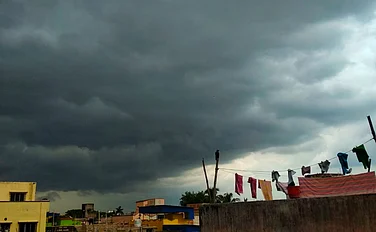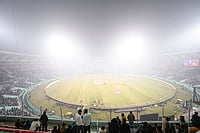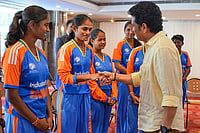"Mr Speaker Sir,
I rise to present the Budget Estimates for 2004-05 for the IndianRailways. The previousGovernment had presented an interim budget on 30th January, 2004 whenapproval for'Vote-on-Account' for the first four months of this financial year forrailways'expenditure was obtained.
Sir, this is the first Railway Budget of the United ProgressiveAlliance Government, whichassumed office on 22nd May, 2004. Within the short time available tome, I have made anattempt to identify the challenges and difficulties faced by theRailways and outlinemeasures to overcome the same apart from taking note of thrust areas ofthe Common MinimumProgramme. In this regard I look forward to the valuable inputs of theHon'ble members ofthis august House. In fact, to start with, I have already written toall the members ofthis and the Upper House indicating the on going projects and importantworks in theirrespective areas and inviting their suggestions for further improvementin the facilities.Special attention will be given to these suggestions and appropriatedecision will betaken on the proposals relating to projects after carrying out surveyswherever necessary,giving primacy to the more neglected areas.
Indian Railways, the prime movers of the nation, have the distinctionof being one of thelargest railway systems in the world under a single management. Itscontribution to thenation's progress is immeasurable and it has a dual role to play as acommercialorganization as well as a vehicle for fulfillment of aspirations of thesociety at large.It is an important catalyst to growth of trade, industry and theeconomy as a whole, withimmense potential for providing indirect employment. Considering this,the UnitedProgressive Alliance Government attaches the highest priority to thedevelopment andexpansion of railway infrastructure as mentioned in the Common MinimumProgramme. Thetravails suffered by the Railways in the last few years, particularlyon the safety front,need to be overcome. President's address to the joint session ofParliament emphasizes theGovernment's intention to modernize the railway network keeping boththe economic andsocial dimension in mind.
Railways have initiated many policy changes to meet the requirements ofits customers, beit freight or passenger services. While continuing the process ofreforms, themodernization of the Railways, replacement and renewal of assets,particularly, the trackrenewal and safety of passengers will be the thrust areas for theRailways. Other priorityareas will be cleanliness of coaches and railway premises, particularlythe stations andimprovement in passenger amenities. Yet another thrust area will becontrol overexpenditure and stepping up of measures to prevent leakage of revenue.
There has been a shortage of resources for investment on Railways,which needs to beenhanced substantially to take care of the priority areas, viz.,safety, development andexpansion of the system. Railways will continue to strive to effectimprovements whereverneeded. I have had deliberations with the Hon'ble Prime Minister andHon'ble FinanceMinister who have been kind enough to assure that requisite funds willbe made availablein the course of this year for Railway safety.
Indian Railways is committed to improve its internal resources. Forthis, we will strictlyimplement a two-pronged strategy with full sincerity. On the one hand,aggressivemarketing efforts will be launched to enhance the earnings and leakageof revenue will bearrested at all identified points, e.g., ticket less travel and othermalpractices, etc.On the other hand, operating expenses will in no way be allowed toexceed the barestminimum requirement. Optimum utilization of human resources andcost-effective use ofother assets will be ensured. Utmost economy will be maintained ingeneral expenditure.
Review of Performance in 2003-04
I am glad to report that in the financial year 2003-04 that has justended, the Railwayshave moved 557.39 million tonnes of originating revenue earningtraffic, against thetarget of 550 million tonnes and 38.65 million tonnes higher than theprevious year'sloading. This is the second successive year when Indian Railways haveregistered around 20million tonnes or more of incremental revenue loading. Passengertraffic registered agrowth of about 3% during the year. There has been an increase of Rs.240 crore over theearnings projected in the Revised Estimates and a savings of Rs. 491crore in the OrdinaryWorking Expenses. The Operating Ratio of the Railways as perapproximate actuals is likelyto improve to 92.1 percent as against 94.1 percent budgeted for theyear. The finalaccounts for the year are under compilation and indications throughapproximate figuresare that there may be only a marginal variation. Plan expenditure isexpected to be aroundRs. 13,311 crore. Despite the improved performance of the Railways Iwould not like toremain contented. Rather I would be striving to improve upon thisperformance further.With a commercial orientation, aggressive marketing and economymeasures, the Railwayswould be continuously working towards further improving their financialperformance.
Safety
Sir, the biggest challenge that Indian Railways face today is ensuringsafe transit ofpassengers. I would like to assure the Hon'ble Members that safety inrail operationswould be accorded the highest priority.
As a result of various safety measures and sustained efforts, thenumber of consequentialtrain accidents has come down from 473 in 2000-01 to 414 in 2001-02,351 in 2002-03 andfurther 325 in 2003-04. This has been the lowest number of accidentsever, reflecting aconsiderable reduction in the year 2003-04 over 2000-01. The number ofconsequential trainaccidents per million train kilometres has also come down to 0.39against the figure of0.44 during the preceding year. The effort will be to bring this downeven further.
Special Railway Safety Fund (SRSF) of Rs. 17,000 crore was createdw.e.f. 1.10.2001 towipe out arrears in renewal of overaged assets viz., track, bridges,rolling stock &signalling gears besides safety enhancement works over a six-yearperiod. Considerableprogress has been made in the execution of works sanctioned under thisfund. 8938kilometres of track have been renewed up to 31.3.2004 out of the totaltarget of 16,538kilometres to be covered up to 31.3.2007. The work of replacement ofover-aged signallingsystems with modern systems has been completed at 441 stations. Thework is in progress at1053 other stations. Interlocking at level crossings with signals hasbeen completed at387 gates during 2003-04, bringing the total of inter-locked levelcrossings to 7095 outof 16549 manned level crossings. With a view to reducing accidents atlevel crossings,provision of Train Actuated Warning Device (TAWD) has been undertakenat selected 90 levelcrossings. The device will warn road users and gatemen of theapproaching train byemitting a siren and through flashing lights. Under SRSF, trackcircuiting works are inprogress at about 5300 locations. Work has so far been completed atabout 1700 locations.
Railways have given very high priority to the work of rehabilitationand strengthening ofold bridges. Of the 2700 bridges to be rehabilitated or rebuilt throughSpecial RailwaySafety Fund, 1306 bridges have been completed upto 31-3-2004. In thecurrent year, 411bridges are to be rehabilitated.
Indian Railways have finalized a rational criteria for manning ofunmanned level crossingsbased on the volume and nature of road and rail traffic at the levelcrossing andvisibility conditions. It is planned to man over 1280 unmanned levelcrossings over aperiod of time, with the more vulnerable level crossings being givenpriority.
New Measures for Safety
Block Proving by Axle Counters, Train Protection and WarningSystem andAnti-Collision Device.
Fresh initiative has been taken to introduce a system of 'electronicverification' ofcomplete arrival of train at stations by means of 'Block Proving' byAxle Counters alongwith a major thrust for development of indigenous Digital Axle Countersfor the first timein the country. The latter has been developed under a joint researchproject of theMinistry of Railways and Department of Science and Technology. Railwayshave taken theinitiative for provision of Train Protection and Warning System (TPWS)for providing anaid to driver to prevent him from passing signals at danger as a safetymeasure. Thesystem provides a warning to the driver of approaching a signal atdanger and if thedriver fails to react the system will apply brakes automatically. Thisproven and failsafesystem is being provided on Southern & North Central Railways onapproximately 280Track Kilometres. Provision of Anti-Collision Devices (ACDs) on about1700 Route Kms. ofNortheast Frontier Railway has been taken in hand and is likely to becompleted during2004-05.
Safety on long welded rails
Indian Railways have a substantial length of long and continuous weldedrails. With a viewto ascertain actual forces in them, it is proposed to develop fieldmethods to measureactual forces occurring in rails so that necessary remedial action maybe taken beforeunsafe conditions develop.
Transportation of Explosives and inflammable materials in thetrains
Incidents of fire in the coaches and luggage vans of passenger carryingtrains during therecent past have caused serious concern. Prohibition on carriage of anytype of explosivesand inflammable materials including LPG cylinders, kerosene stoves,etc., other than thoserequired for security purposes or by the armed forces, by any passengercarrying trainwill be strictly enforced.
Institute of Rescue and Medical Relief
Disaster Management has been recognized as a priority area on theIndian Railways. Tostrengthen the system, a number of initiatives are being taken. Theseinclude setting upof an "Institute of Rescue and Medical Relief" at Bangalore. It isproposed toset up a project at a cost of Rs. 10 crores to give a fillip to thetraining activities.This institute shall act as a repository for all modern extrication andmedical relieftechniques to ensure quicker rescue and provide prompt medical relief,comparable tointernational standards.
Security
Consequent upon the recent amendments to the Railways Act, 1989 &RPF Act, 1957,Railway Protection Force (RPF) has been entrusted with additionalresponsibilities forescorting passenger trains in vulnerable areas and to have control onaccess andregulation and general security at platforms to supplement the effortsof state police/GRPfor enhanced security of the passengers. Both the amended Acts havecome into force witheffect from 1st July, 2004. To start with, manpower has been withdrawnfrom certain lessimportant activities so that passenger security takes precedence overprotection ofproperty. Accordingly, escorting of trains will be shared with GRP inthe initial stages. Zonal General Managers have been directed to chalk out the plans inthis regard.
To address the problem of shortage of personnel in the Force to carryout the new duties,and to speed up the process of filling up of vacancies, it has beendecided to restore theearlier procedure of direct recruitment by the Security departmentitself instead ofthrough Railway Recruitment Boards. This will expedite the availabilityof manpower andstrengthen the Force.
Skills of the existing personnel of R.P.F. have been upgraded by givingthem intensivere-orientation training at zonal training schools and RPF Academy. Thistraining capsuleis comprehensive and consists of legal provisions regarding arrest,seizure, personalattendance, summons, warrants, handling of prisoners, human rightsviolations, custodialcare, gender justice, juvenile offenders, etc.
Concern has been expressed about the cases of drugging of unwarypassengers on the trainsand robbing them of their belongings. Railways have taken certainmeasures to combat thismenace by educating the public. In this connection I have instructedthe RPF that theyshould try to identify the criminal gangs engaged in the crime ofdrugging and hand themover to the GRP.
Modernisation
Research Projects in Bridge Engineering
Indian Railways are interacting with various Indian Institutes ofTechnology and premierresearch institutes in India and abroad and Advanced Railway Systems inthe field ofBridge Engineering. It is proposed to take up research and developmentprojects in areasof protection from earthquake and rehabilitation of bridges, residuallife analysis forconcrete and masonry bridges, high performance concrete and corrosionprotection systemsfor bridges.
Rehabilitation of Arch Bridges
There are a large number of arch bridges on Indian Railways. A numberof bridgeimprovement and rehabilitation measures have already been undertaken inthe recent past.In addition, it is proposed to extend the useful life of a large numberof arch bridges byabout 25 years by adopting techniques in collaboration withInternational Union ofRailways (UIC).
Corrosion Resistant Wagons
Corrosion in conventional wagons affects their availability andproductivity and reducestheir life. In order to overcome this problem, field trials ofstainless wagons are inprogress. In addition, it has been proposed to introduce aluminium bodywagons and conductfield trials. This would result in reduced tare weight and higherpayload per wagon ascompared to the conventional wagons.
Crew Friendly Driver's Cab and Brake Van
Fatigue enhances vulnerability of Drivers and Guards to causeaccidents. Improvement inthe working conditions of such staff with a view to reduce theirfatigue level on run is,therefore, a priority area for Indian Railways. A number ofimprovements have beenstandardized and are being incorporated in a phased manner in driver'scab and guard'sbrake van to make the working environment of crew better and improvingefficiency. The newdiesel locos and guards' brake vans will be provided with thesefeatures.
Modernisation of EMUs & Electric Locos
Three phase electric traction system based on most advanced InsulatedGate BipolarTransistor (IGBT) Technology is proposed to be introduced for EMUtrains in Mumbaisuburban section. This system provides higher reliability and improvedenergy efficiency.Progressively this technology is also proposed to be developed for highhorse power threephase electric locomotives.
Strategic Management Institute
There is a need to prepare Railway Managers to meet the futurechallenges in railoperations. This necessitates pooling of training resources availableworld over. It is,therefore, proposed to set up an International Railway StrategicManagement Instituteunder the aegis of International Union of Railways (UIC).
Computer based Centralised Traffic Control
Under a project funded by German Development Bank (KfW) modern computerbased CentralisedTraffic Control (CTC) System is planned to be introduced for the firsttime onGhaziabad-Kanpur high speed, high density route to improve safety andoperation.
Material Management Information System (MMIS)
A pilot project on Material Management Information System (MMIS)incorporating the on lineexchange of information on material management has been successfullydeveloped andimplemented by Central Railway. Now this system is proposed to beextended to all otherZonal Railways for effective material management, which will improvematerial availabilityand turn over ratio.
Introduction of Information Technology for Permanent Way MaterialsManagement System hasbeen done on 21 divisions so far. Setting up of infrastructure onbalance 46 divisions isin advanced stages and is targeted for completion during the year. Thesystem provides forproper and concurrent accountal of materials and facilitates accurateverification ofphysical stock including released material. Thus, the system improvesefficiency andarrests leakage of revenue through theft, pilferage, etc.
E-procurement
Railways are working towards adoption of E-procurement. A pilot projecton NorthernRailway envisages putting all purchase activities on the internet,wherein issue oftenders, receipt of bids, issue of contracts etc. would be done online.The introductionof this system will bring transparency and improve efficiency by way ofreducedprocurement time cycle and expeditious payment to suppliers. Aftersuccessful completionof the pilot project on Northern Railway, E-procurement will beextended to other zonalRailways.
Improvements to Claims Management
Railways have embarked on a programme of computerization of 'ClaimOffices' so as toprovide on line information to claimants about the status of claims.This will help thecustomers to find unconnected consignments and will also be a powerfultool in reducingthe duplication of claims. Computerized registration of claims in ZonalRailwayHeadquarters has already been started from April 2004 and it isexpected that fullcomputerization of claim offices will be completed during the currentfinancial year.
In order to help the rail users, the rules & procedures inconnection withcompensation claims in respect of both "accident" and "loss/damage ofgoods" have been incorporated in the Indian Railways website.
Simplification of refund procedure
Under the normal rules, refund of unused tickets is admissible upto amaximum of 12 hoursafter departure of the train. In order to facilitate refund thereafterdirectly from thePRS terminals, a Computerised Coaching Refund System has been started.Under the revisedrules, refund shall be admissible on unused reserved and RAC ticketsupto five days fromthe scheduled departure of the train from its originating station. Somezonal railwayshave started granting refund under this scheme. The project will befully implementedduring the current year.
Unreserved Ticketing System
About 92 percent of the railway passengers travel without reservationin unreservedcoaches in trains in the country. To help these railway passengers,Indian Railways havedeveloped Unreserved Ticketing System (UTS).
The Rail Mantri Speaks
Full prepared text of the speech by the Railyway Minister while presenting the Railway Budget for 2004-2005 in the Lok Sabha.

The Rail Mantri Speaks
The Rail Mantri Speaks
Published At:
MOST POPULAR
WATCH
MORE FROM THE AUTHOR
PHOTOS
×

















